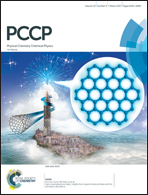Observation of covalent and electrostatic bonds in nitrogen-containing polycyclic ions formed by gas phase reactions of the benzene radical cation with pyrimidine†
Abstract
Polycyclic aromatic hydrocarbons (PAHs) and polycyclic aromatic nitrogen heterocyclics (PANHs) are present in ionizing environments, including interstellar clouds and solar nebulae, where their ions can interact with neutral PAH and PANH molecules leading to the formation of a variety of complex organics including large N-containing ions. Herein, we report on the formation of a covalently-bonded (benzene·pyrimidine) radical cation dimer by the gas phase reaction of pyrimidine with the benzene radical cation at room temperature using the mass-selected ion mobility technique. No ligand exchange reactions with benzene and pyrimidine are observed indicating that the binding energy of the (benzene·pyrimidine)˙+ adduct is significantly higher than both the benzene dimer cation and the proton-bound pyrimidine dimer. The (benzene·pyrimidine)˙+ adduct shows thermal stability up to 541 K. Thermal dissociation of the (C6D6·C4H4N2)˙+ adduct at temperatures higher than 500 K produces C4H4N2D+ (m/z 82) suggesting the transfer of a D atom from the C6D6 moiety to the C4H4N2 moiety before the dissociation of the adduct. Mass-selected ion mobility of the (benzene·pyrimidine)˙+ dimer reveals the presence of two families of isomers formed by electron impact ionization of the neutral (benzene·pyrimidine) dimer. The slower mobility peak corresponds to a non-covalent family of isomers with larger collision cross sections (76.0 ± 1.8 Å2) and the faster peak is consistent with a family of covalent isomers with more compact structures and smaller collision cross sections (67.7 ± 2.2 Å2). The mobility measurements at 509 K show only one peak corresponding to the family of stable covalently bonded isomers characterized by smaller collision cross sections (66.9 ± 1.9 Å2 at 509 K). DFT calculations at the M06-2X/6-311++G** level show that the most stable (benzene·pyrimidine)˙+ isomer forms a covalent C–N bond with a binding energy of 49.7 kcal mol−1 and a calculated collision cross section of 69.2 Å2, in excellent agreement with the value obtained from the faster mobility peak of the (benzene·pyrimidine)˙+ dimer. Formation of a C–N covalent bond displaces a hydrogen atom from a C–H bond of the benzene cation which is transferred to the second pyrimidine nitrogen atom, thus preserving the pyrimidine π system and yielding the most stable (benzene·pyrimidine)˙+ isomer. The calculations also show less stable non-covalent electrostatically bonded perpendicular isomers of the (benzene·pyrimidine)˙+ dimer with a binding energy of 19 kcal mol−1 and a calculated collision cross section of 74.0–75.0 Å2 in excellent agreement with the value obtained from the slower mobility peak of the (benzene·pyrimidine)˙+ dimer.

- This article is part of the themed collection: 2017 PCCP HOT Articles


 Please wait while we load your content...
Please wait while we load your content...